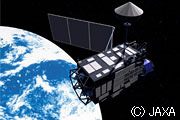Archived content
NOTE: this is an archived page and the content is likely to be out of date.
"Kaguya" lunar orbiter

Fujitsu also played an important role in the "Kaguya" project of "to understand the origin and evolution of the moon" through the construction of ground data handling systems that performed, calculations for entry into lunar orbit, maintaining lunar orbit, analyzing the gravitational field, and processing observational data. This was coupled with the development of the onboard three-dimensional terrain camera and visible/near infrared region sensor.
 An image of the lunar surface capture by the terrain camera that Fujitsu contributed to the development of LISM
An image of the lunar surface capture by the terrain camera that Fujitsu contributed to the development of LISMLISM [Terrain camera (TC), Multiband imager (MI), Spectral profiler (SP)]
- Terrain camera (TC): High resolution stereoscopic viewing of the lunar surface to clarify the three-dimensional terrain across the entire moon's surface.
- Multiband imager (MI): Visible and near infrared multiband imaging to clarify the geology of the moon.
- Spectral profiler (SP): Visible and near infrared continuous spectroscopy to clarify the types of minerals on the moon.
Related Link
Footnotes
1: "Kaguya" lunar orbiter
"Kaguya" is a lunar probe that was launched by the Japan Aerospace Exploration Agency (JAXA) on 14th September 2007 with the goals of collecting data for learning about the origin and evolution of the moon and to prove the technology for entering lunar orbit and orbit attitude control.
2: Tanegashima Space Center
The Tanegashima Space Center was established in 1969 when the former National Space Development Agency of Japan was formed, and is the largest rocket launch site in Japan.


